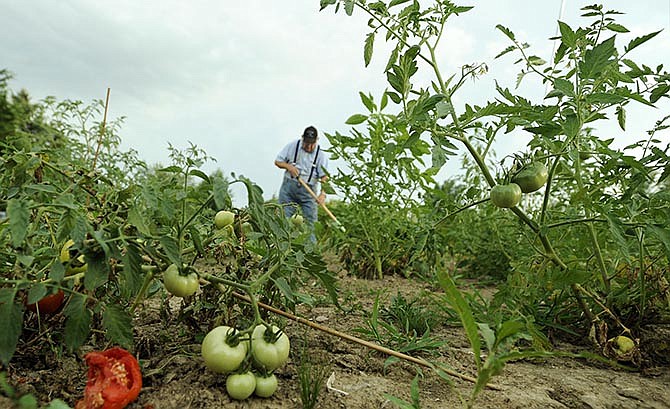Here is some timely garden advice from now retired James Quinn, Horticultural specialist.
Vegetables
Many gardeners are in a hurry to plant tomatoes, but if you missed the early planting of early May, don't despair: They will do very well planted all the way until the end of June. Following getting established, around seven to 10 days, the plants will benefit from drier soil conditions; it will help them root deeper. For season-long productivity it is advised to provide supplemental nitrogen three times - one to two weeks before first tomato ripens, two weeks after picking first tomato and then one month later. Adequate nitrogen will promote deep green foliage, which improves resistance to foliar disease. Determine the method you'll use for supporting tomatoes and begin using about three weeks after planting. If using cages, consider providing additional support to them by driving a stake or similar adjacent to them and tying to it. When using stake and weave, consider most popular home garden tomatoes are indeterminate and will grow above the typical stakes or posts. So obtain the tallest metal posts or the tallest and thickest wooden stakes. Plastic twine will hold up better over the entire season.
June is the time to do some late plantings to either extend the summer harvest or have crops for fall. Try another planting of sweet corn or green beans in early to mid-June. Plant pumpkins and winter squash types now. Seed Brussels sprouts in May and transplant in June. Heat tolerance of lettuce has been improved; try one of these varieties, seeding in late May or early June and enjoy the harvests into July and even August.
For Cucurbits - cucumbers, squash (winter or summer), pumpkins, and melons - watch for cucumber beetles in May and squash bugs in June and treat with an insecticide at first sign. Permethrin is the best synthetic option and last year a new organic insecticide received some positive reviews, Azera. Retreat with insecticide whenever cucumber beetles or squash bugs are seen. To protect bees (which are needed for pollination) apply the insecticide in the evening. Including a spreader sticker generally improves the efficacy of the insecticide.
Fruits
Strawberries will bear in May or June. Consider renovating them following the last fruit harvesting; it is an important step often skipped. Summer bearing raspberries and early blueberries will begin bearing at the end of June. Look for gooseberries in June, but they may go into July if you want them to ripen to pink. Regarding berries, Spotted Wing Drosophila, did occur widely. The pest population starts low and gradually builds, shifting between the different berries (strawberries, then gooseberries, to Mulberries, summer raspberries and blueberries, etc.). Become familiar with the pest and its damage. Weekly treatments with insecticide(s) to ripening fruit is needed for control, as well as prompt harvesting of the berries and cleaning up of all old or spoiling fruit. This pest can also infest peaches.
Trees and shrubs
Pruning of spring flowering trees and shrubs should be completed before the month's end. Trees and shrubs may still be fertilized before the end of June.
In a rainy spring, broadleaf trees may be infected by a foliar disease. Anthracnose is common on sycamore and occasionally maples. Fire blight was quite bad in 2014 on Cleveland type pears, and thus it could easily infect trees again this spring; unfortunately control of this disease is very difficult after symptoms develop. Trees with a history of borer problems should receive their first spray at the end of May. Repeat twice at three-week intervals.
Common foliar diseases of evergreen trees should be done in May. Diploida and Dothistroma have been problematic on Scots and Ponderosa pines while spruces have struggled with rhizosphaera needlecast, and SNEED (Sudden Needle Drop of Spruce) in recent years, with blue spruce the most susceptible. To prevent these diseases, apply a broad spectrum fungicide as the candles start to push and again about two weeks later. Combine with an insecticide to prevent bagworms. For pines and euonymus troubled by scale, the crawlers are active in mid- to late May and should be controlled then.
Lawns
Mowing height is important for the different types of lawns. Keep bluegrass cut at 1.5-2.5 inches in height and tall fescue at 2-3.5 inches. Try to mow frequently enough to remove no more than one-third of the total height. There is no need to remove clippings unless excessive. If post-emergence broadleaf weed control is needed, spraying is preferred. That is because most granular products include fertilizer, and late spring fertilization stimulates diseases such as brown patch for cool season lawns. There are now post emergent crabgrass killers for cool season lawns if needed; some of these products also control Bermuda and unwanted zoysia.
Mow zoysia lawns at a 1.5-inch height and remove no more than a half inch at each mowing. Gradually increase the mowing height of zoysia lawns throughout the summer to achieve a mowing height of 2 -2.5 inches by mid-summer. Zoysia lawns should be first fertilized at the end of May and once or twice again through August. Apply no more than 1 pound of actual nitrogen per 1,000 square feet at once and do not exceed 2-3 pounds of actual nitrogen fertilizer per 1,000 square feet per year.
Lastly, if yellow nutsedge is a problem, try to treat it early, which would likely be in May or June at the latest. It is more easily controlled if treated when in the two to four leaf stage. Sedgehammer is an effective product.
Happy gardening!
Peter Sutter is a life long gardening enthusiast and a participant in the MU Extension's Callaway County Master Gardener program. Gardening questions can be sent to [email protected].

